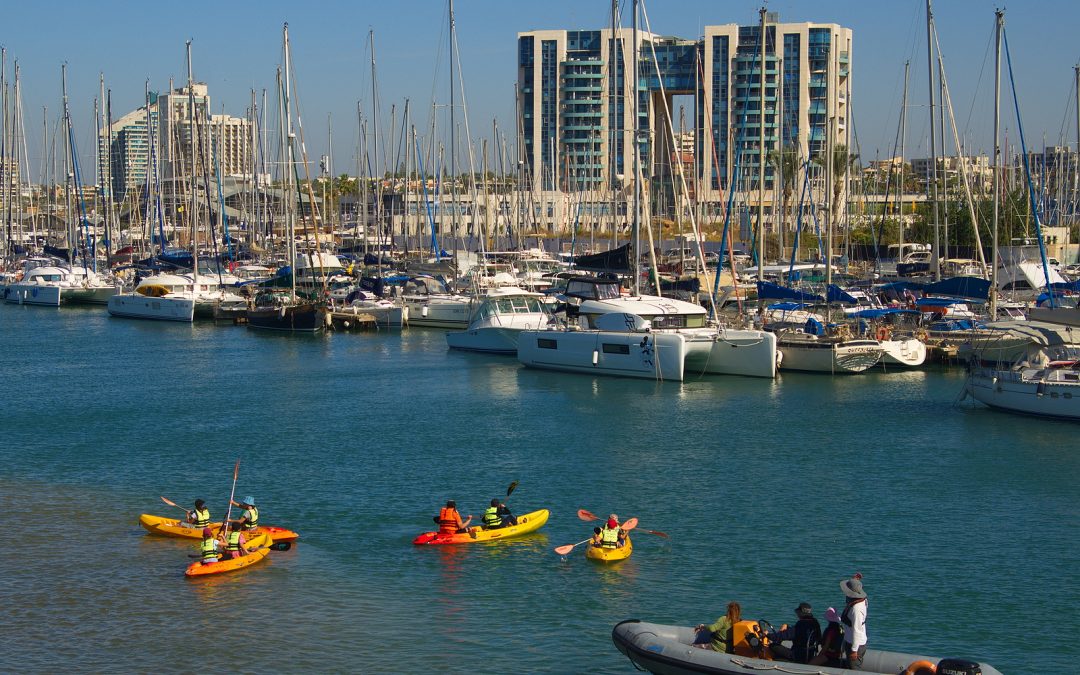Renting a kayak is a fantastic way to explore waterways, whether you’re craving a serene paddle on a calm lake or seeking the thrill of river rapids. With the popularity of kayaking on the rise, numerous rental services have sprung up to cater to both novice and experienced paddlers. These services offer the flexibility to try out different kinds of kayaks without the commitment of a purchase, which can be particularly beneficial for those who kayak infrequently or are new to the sport.

Before embarking on a kayaking adventure, it is crucial to understand several key aspects of kayak rental. Different types of kayaks suit various water conditions and personal preferences, so choosing the right one is essential for a safe and enjoyable experience. It’s also important to consider the duration of the rental, the cost, and the proximity to your desired paddling destination. Preparing adequately for the day ahead, including knowing what essentials to bring along, will make the experience smoother and more pleasurable.
Key Takeaways
- Kayak rentals offer flexibility and variety for paddlers of all levels.
- Choosing the right kayak and preparing adequately are critical for a safe trip.
- Considering environmental sustainability is important when renting kayaks.
Benefits of Kayaking
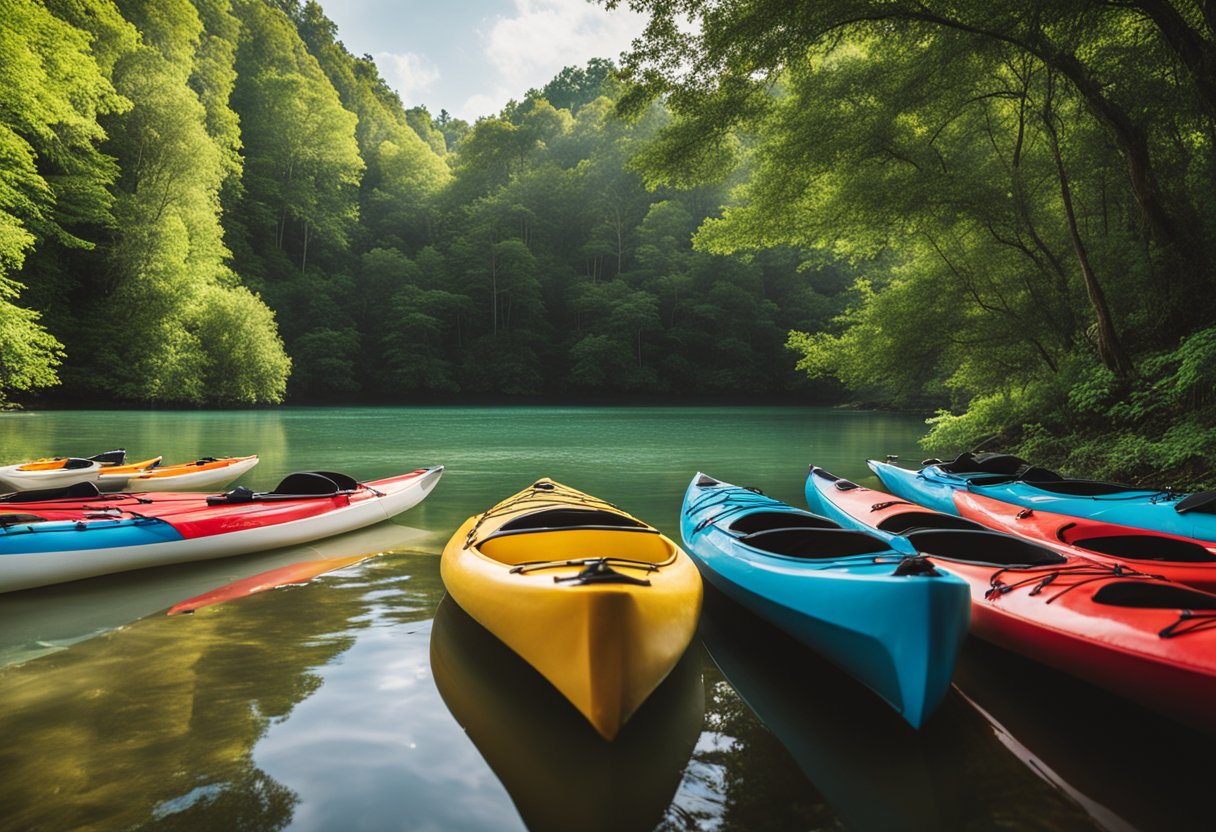
Kayaking offers a range of advantages, from enhancing physical health to contributing positively to one’s mental state, as well as being a low-impact activity that benefits the environment.
Health and Fitness Perks
Kayaking serves as an excellent form of cardiovascular exercise, engaging multiple muscle groups. The act of paddling works the upper body extensively, including the back, shoulders, arms, and chest. It also engages the core and can improve overall strength and endurance. An individual typically burns between 300 to 500 calories per hour while kayaking, making it an efficient way to manage weight.
- Muscles Worked:
- Upper Body: Back, Shoulders, Arms, Chest
- Core: Obliques and Abdominal Muscles
- Calories Burned: Approximately 300-500/hr
Mental Well-Being
Kayaking can significantly enhance mental health by providing stress relief and a sense of tranquility from being on water. It has been shown to improve mood and help with mental clarity. The rhythmic nature of paddling and the need to maintain balance and coordination offer a mindful experience that can be meditative. Observing wildlife and surrounding natural beauty also contributes to psychological restoration and relaxation.
- Stress Relief: Being on water and paddling rhythmically reduces stress levels.
- Mindfulness: The concentration needed for balancing and navigating aids mental clarity.
Environmental Impact
The environmental footprint of a kayak is minimal, making it an eco-friendly option for exploring natural habitats. Since kayaks do not use motors, they do not emit pollutants into the water or air, and their quiet nature allows for the observation of wildlife without causing disturbance. Kayakers often gain an appreciation for nature and become advocates for conservation. Additionally, kayaking prompts users to be vigilant about protecting the environment by being mindful of sunscreen and other products that could affect water quality.
- Pollution-Free: No motor emissions from kayaks.
- Wildlife-Friendly: Allows close observation without disturbing animals.
- Conservation Awareness: Encourages responsible use of personal products, like biodegradable sunscreen, to protect aquatic ecosystems.
Kayak Rental Advantages
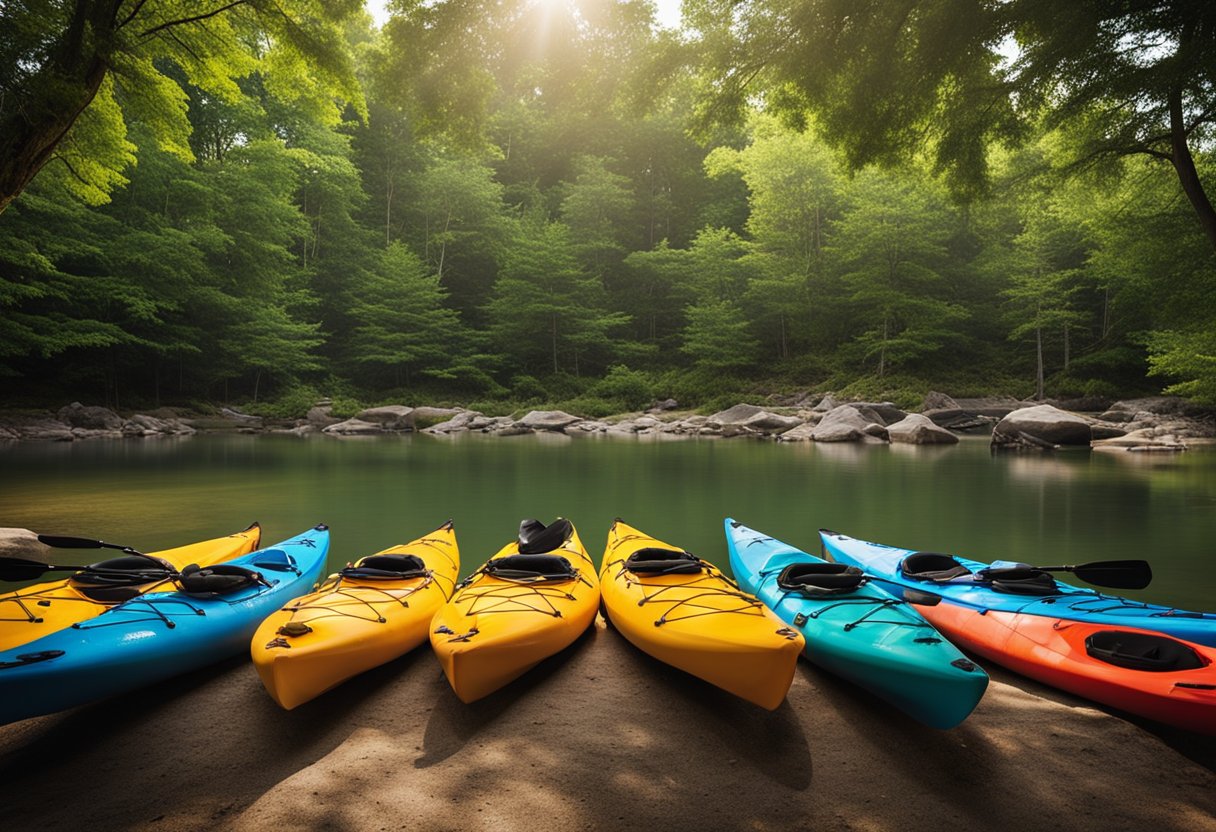
Renting a kayak offers a range of benefits, from cost savings to a wide variety of kayaking experiences. Renters can appreciate a tailored adventure that suits their budget and interests.
Cost-Effectiveness
Renting a kayak is often more affordable than purchasing one, especially for occasional users. Pricing varies based on the type and duration of the rental but typically includes all necessary equipment like life jackets, which adds to the value.
- Single Kayak: Average cost for a half-day rental – $25-$40
- Tandem Kayak: Average cost for a half-day rental – $40-$60
- Pedal Kayaks: Slightly higher in price due to their mechanical complexity
Convenience
Renters benefit from the convenience of not having to transport or store the kayak. Rental locations are usually situated near paddling spots, eliminating the hassle of carrying the equipment to and from the water.
- Locations often offer on-site assistance.
- No maintenance or storage concerns for renters.
Variety of Options
Kayak rentals provide access to a diverse range of kayaks suitable for different skill levels and water conditions.
- Recreational Kayaks: Ideal for calm waters, they offer stability and ease of use.
- Tandem Kayaks: Designed for two paddlers, perfect for couples or friends.
- Pedal Kayaks: Allow for hands-free operation; great for fishing or photography enthusiasts.
Factors in Choosing a Kayak Rental
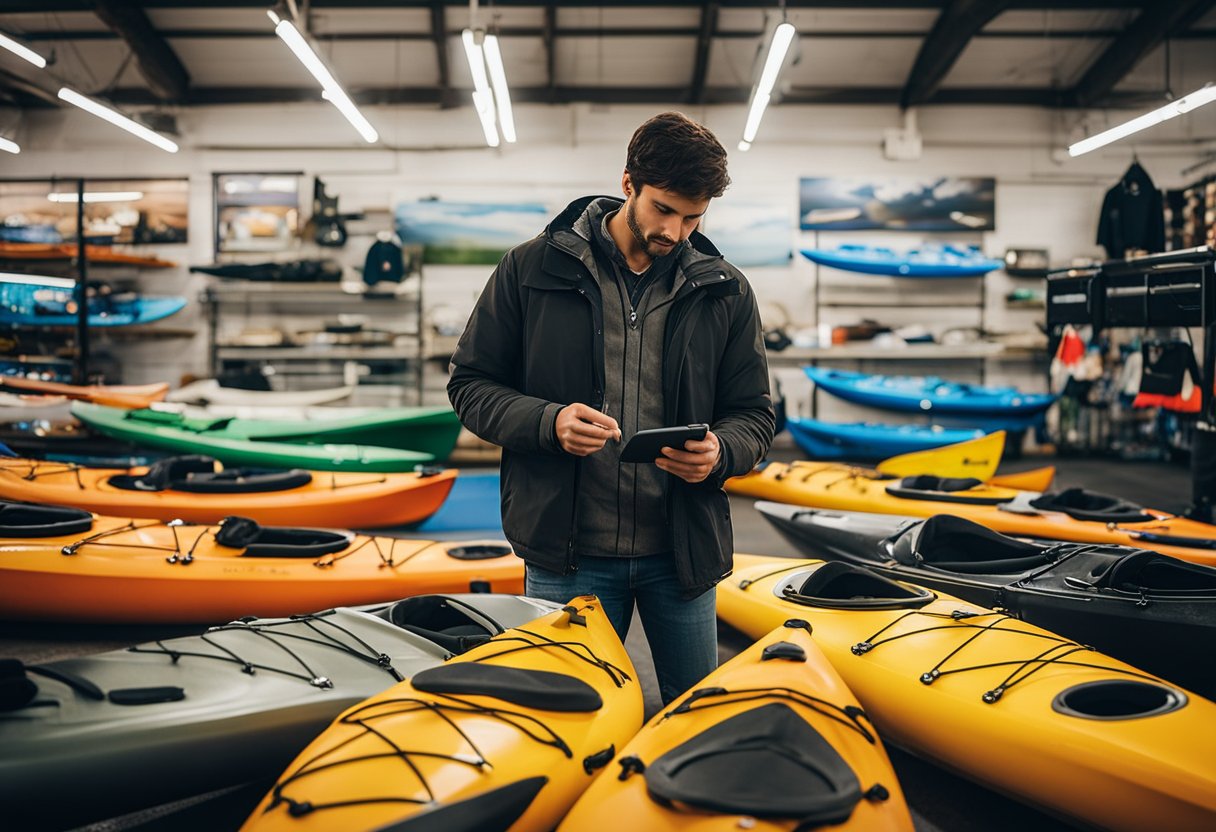
When selecting a kayak rental service, one must consider various important aspects that directly affect the experience. The choice of location, the quality of equipment provided, and the terms of the rental agreement, including insurance, can significantly influence the success of a kayaking adventure.
Location and Destination
The initial factor to assess is the Location and Destination. Renters should identify if their destination is a river, lake, or coastal area, as this will dictate the kayak’s design suitable for the environment. Weather conditions are also crucial; therefore, checking local forecasts is recommended to ensure safety. Accessibility to the launch site is another consideration, as some services may offer transportation or shuttles to the water.
- River Destinations: Fast-moving water requires sturdy and maneuverable kayaks.
- Coastal Areas: Look for sea kayaks that offer stability in open water.
- Weather: Calm, sunny days may only require a hat and sunscreen, while colder, rougher weather demands proper attire and gear.
Equipment and Accessories
Next, the quality and availability of Equipment and Accessories is paramount. Reputable rental services should provide personal flotation devices (PFDs) and ensure they are U.S. Coast Guard-approved. Kayakers should also inquire if additional accessories like paddles, lockers, and maps are included. A checklist can be useful:
- PFDs (Personal Flotation Devices)
- Paddles: Right size and strength for the intended use.
- Accessories: Dry bags, lockers for personal items, and navigational aids.
Rental Terms and Insurance
Finally, understanding the Rental Terms and Insurance options is crucial for a hassle-free experience. Rentals typically outline the duration of use, costs, and liability waivers. It’s important to ask about the company’s policy on damage and the scope of coverage included. Potential renters should look for:
- Liability: Nature and extent of liability protection.
- Insurance: Options for reducing risk in case of accidents or loss of equipment.
Renters must review all documents thoroughly before agreeing to the terms to avoid unforeseen charges or coverage gaps. It is also advisable to explore any partnership discounts or offers that can provide additional value.
Preparation Tips
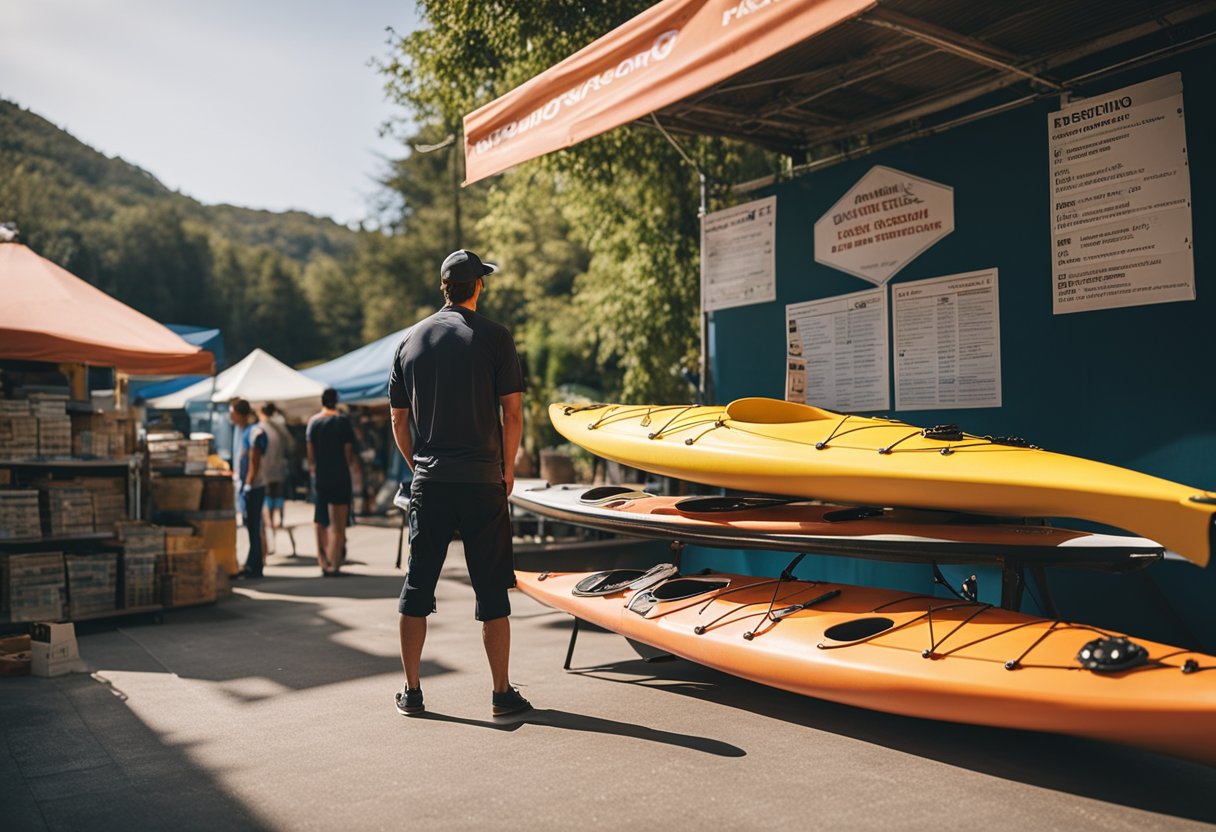
When renting a kayak, one should prioritize safety, understand the weather conditions, and map out their paddling route. These steps will ensure a smoother kayaking experience.
Safety Measures
Before heading out, every kayaker must wear a life jacket. It’s non-negotiable and is critical for personal safety. Even skilled swimmers should not underestimate the importance of a life jacket in the event of a capsize.
- Equipment Check: Verify that all safety gear is present and in good condition:
- Life jacket
- Whistle
- Bilge pump
Check the Weather
Kayaking conditions can be heavily impacted by weather changes. They should check the local weather forecast before departure to anticipate:
- Wind Speed: Strong winds can challenge control of the kayak.
- Temperature: Dress appropriately for the weather to avoid hypothermia or heat exhaustion.
Plan Your Route
Planning your route is essential to avoid getting lost and to ensure that they have enough energy and supplies to complete the trip.
- Float Plan: Inform someone on land of their float plan, including the route and expected return time.
- Landmarks: Identify landmarks along the way to aid navigation.
Setting Up a Kayak Rental Service
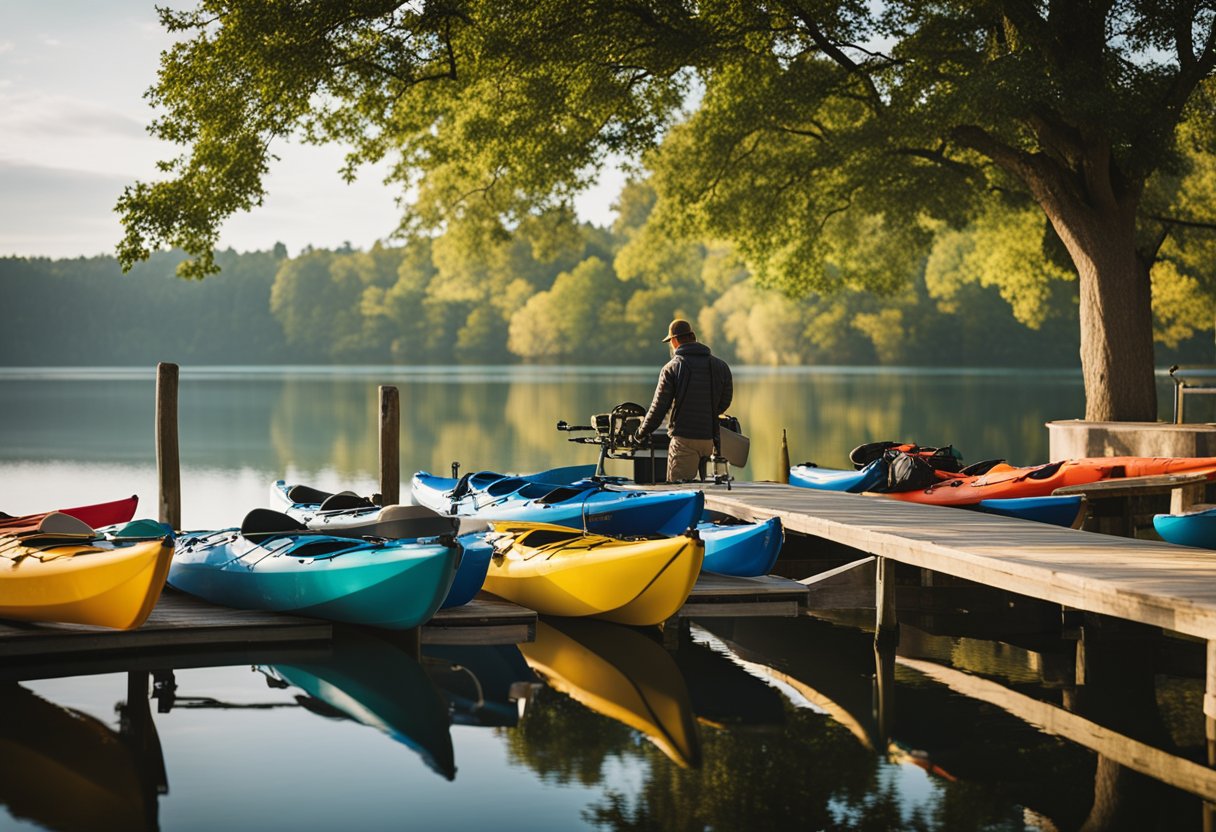
When establishing a kayak rental service, entrepreneurs must carefully plan their business model, ensure legal and financial compliance, and adopt effective marketing strategies to secure a successful entry into the market.
Business Model Insight
A kayak rental business typically operates by providing customers with the equipment necessary for recreational or sport kayaking. Entrepreneurs must decide whether to position their business within a marina, near a tourist hotspot, or in partnership with hotels that may want to offer kayaking as an amenity. The structure of the enterprise can greatly influence its potential profit. For instance, forming a limited liability company (LLC) is a favored choice as it protects personal assets while conveying a professional image. Key aspects of the business model should be outlined in a comprehensive business plan, which includes analysis of local competition, pricing strategies, operational hours, and seasonal considerations.
- Business Structure: Opting for an LLC is recommended to shield personal assets from business liabilities.
- Operational Logistics: Determine hours of operation, location, and services offered, balancing demand with potential profit.
Legal and Financial Preparation
To start a kayak rental company, one must first obtain an Employer Identification Number (EIN) from the IRS. This is essential for tax purposes and is a requisite step to open a business bank account. As a small business, kayak rental services may benefit from certain tax advantages and should thoroughly understand local regulations and insurance requirements. Financial planning also includes budgeting for initial investments which may include the purchase of kayaks, life jackets, paddles, and safety equipment.
- Compliance: Secure an EIN and research local regulations tied to water-based activities.
- Financial Planning: Open a dedicated business bank account and plan for the initial investment and ongoing expenses.
Marketing Strategies
Marketing is crucial for any canoe and kayak rental business to attract customers and generate revenue. In today’s digital age, a strong online presence including a well-designed website and active social media accounts is essential. Additionally, offline marketing tactics, such as partnerships with nearby hotels or tourist centers, can drive business. Offering seasonal promotions or group discounts can be an effective way to increase visibility and cater to different market segments.
- Online Presence: Utilize social media and a business website to broaden reach.
- Partnerships and Promotions: Collaborate with local businesses and implement promotional strategies to attract customers.
Destination Highlights
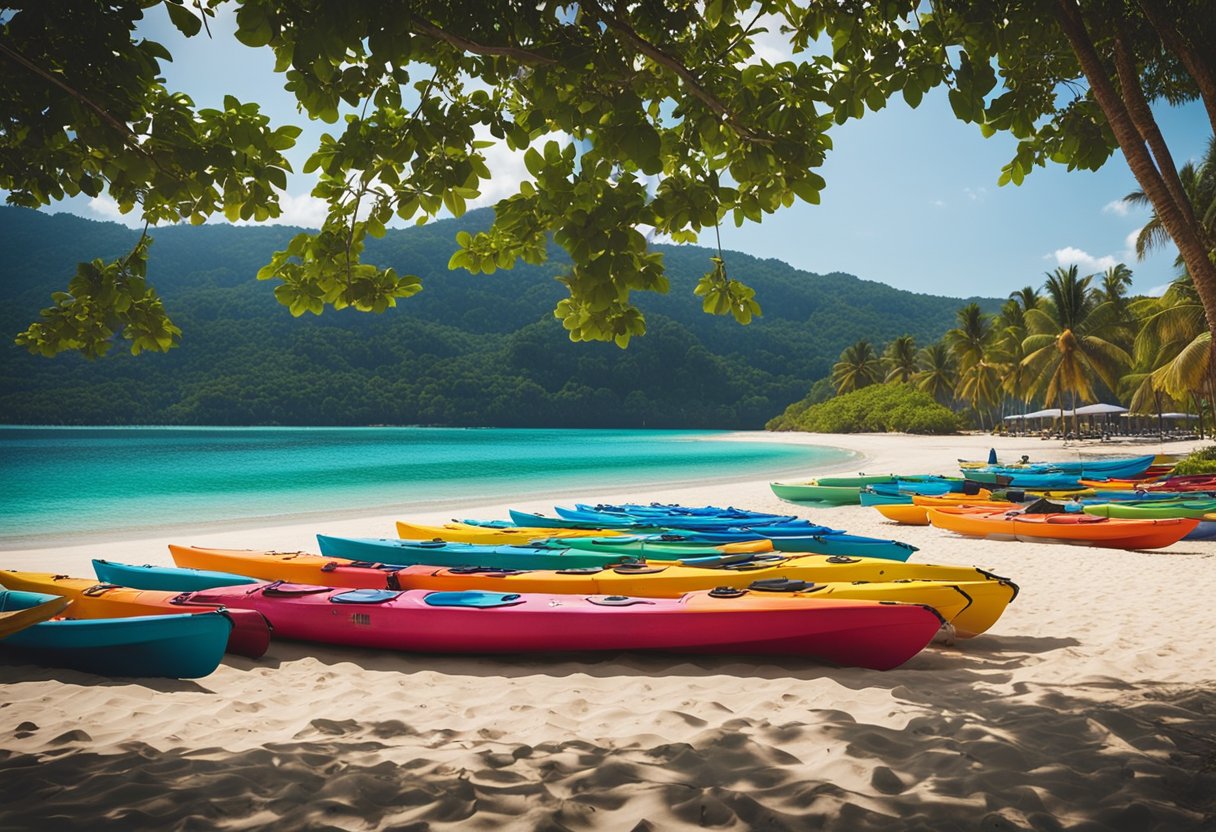
When considering kayak rental options, each destination offers its own unique set of attractions. From serene coastal areas to bustling city waterways, renters have the opportunity to experience diverse environments and encounters.
Coastal Retreats
Coastal regions provide kayakers with picturesque views and the chance to navigate through clear, tranquil waters.
- Wildlife Encounters: Paddlers can expect to see a variety of sea life, such as dolphins, seals, and seabirds.
- Marina Facilities: Many coastal areas boast well-equipped marinas, offering amenities and safety information for a smooth kayaking experience.
River Adventures
Rivers offer dynamic and varied kayaking experiences, from calm waters to challenging rapids.
- Scenic Routes: Kayakers can traverse through diverse landscapes, including forested areas and rocky gorges, often spotting wildlife like river otters or fish.
- Rental Options: Rental options along rivers may range from hourly to multi-day trips, catering to both novices and seasoned paddlers.
Urban Waterways
Kayaking through urban areas allows for a unique perspective of cityscapes and an escape from the hustle and bustle.
- Skyline Views: Paddling in these environments offers a chance to view city architecture from the water.
- Accessibility: Urban marinas often provide convenient access and additional services, such as guided tours or group kayaking events.
Rental Tips for Beginners
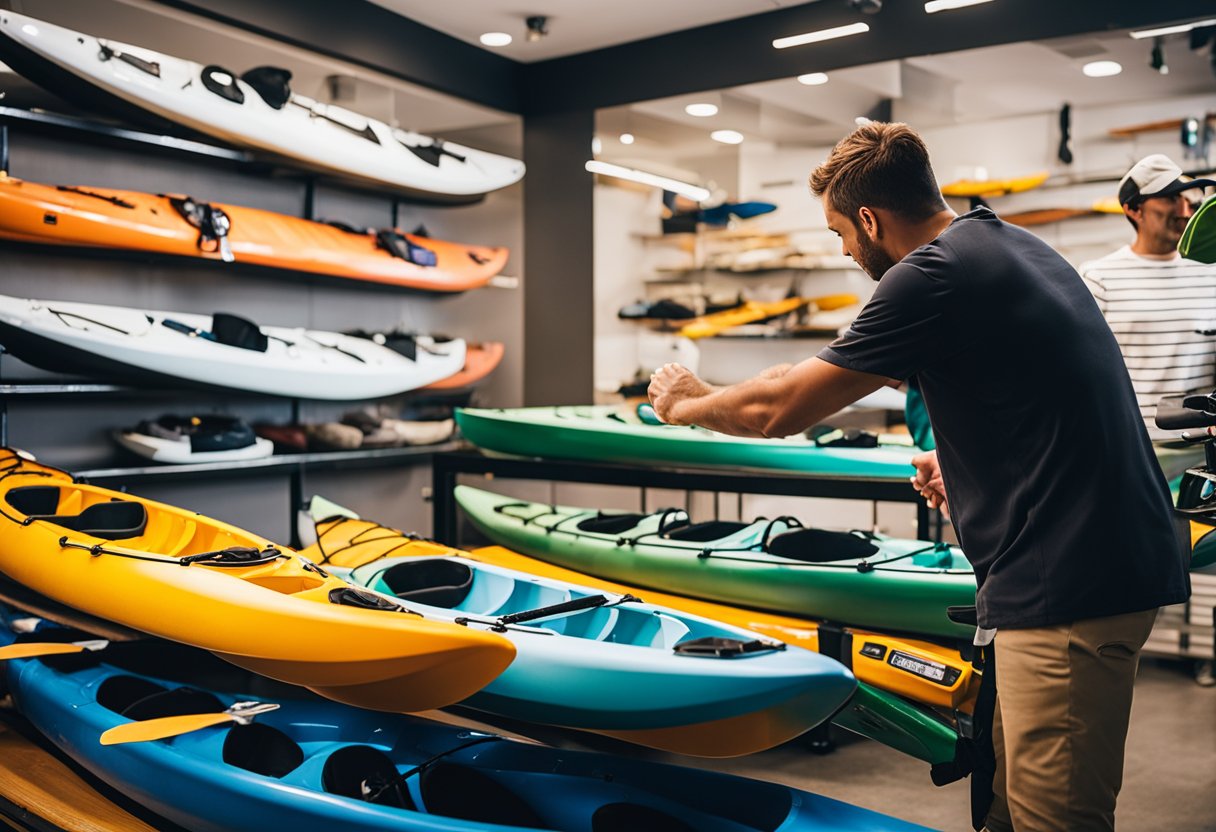
When renting a kayak, it’s important for beginners to consider the type of kayak, understand the rental agreements clearly, and undergo a proper safety briefing to ensure a pleasant and safe experience on the water.
Choosing the Right Kayak
One should select a kayak that matches their skill level and the intended activity. Single kayaks are ideal for those looking to paddle solo and navigate with ease, while tandem kayaks are suitable for two paddlers and can be a good choice for beginners who wish to learn with a partner. The renter should also ensure that an appropriate-sized life jacket is included with the rental.
| Type | Recommended Use | Note |
|---|---|---|
| Single Kayak | Solo paddling | Easier to control for one person |
| Tandem Kayak | Paddling with a partner | Good for beginners to learn together |
| Life Jacket | Mandatory for all water activities | Should fit snugly and be U.S. Coast Guard-approved |
Understanding Rental Agreements
Beginners must read and comprehend the kayak rental agreements carefully. They should scrutinize the pricing details, including hourly rates and deposit information, as well as any limitations or penalties for late returns.
Key Aspects of Rental Agreements:
- Cost breakdown (hourly rate, deposit)
- Duration of rental
- Late return policies and charges
Safety Briefing
Attending a safety briefing conducted by the rental provider is crucial. Beginners will learn how to properly use the kayak, understand basic paddling techniques, and be informed about navigational safety protocols.
Safety Briefing Should Cover:
- Proper use of the kayak
- Correct paddling techniques
- Safety protocols and emergency procedures
It is the responsibility of the renter to actively participate in the briefing and ask questions about any aspect they are uncertain of, particularly pertaining to handling emergencies and understanding the necessary use of the life jacket.
Essentials to Bring
Before heading out on a kayaking adventure, ensuring you have all the necessary essentials will enhance the experience and ensure safety. The items one carries can make a significant difference in comfort and preparedness.
Personal Items
- Sunscreen: Bring a waterproof, high-SPF sunscreen to protect against UV rays.
- Hat: A wide-brimmed hat to shield the face from sun exposure.
- Waterproof bag: For securing personal items that cannot get wet.
Safety Gear
- Life Jacket: A well-fitted life jacket is a must for staying safe on the water.
- Whistle: Carry a whistle to signal for help in case of an emergency.
- First-Aid Kit: A basic kit for handling minor injuries.
Provisions
- Water: At least one liter per person to stay hydrated.
- Snacks: Energy-rich foods like trail mix or granola bars for sustenance.
Sustainability and Conservation
When renting kayaks, it is essential to consider the impact on the environment and the local wildlife. Sustainable kayak rental operations help preserve natural habitats and ensure future generations can enjoy these ecosystems.
Eco-friendly Practices
Materials: Operators should use kayaks made from recycled materials or sustainable sources to minimize environmental damage.
Maintenance: Regular maintenance of kayaks and related equipment reduces the need for frequent replacements and lowers the ecological footprint.
- Cleaning Agents: Biodegradable cleaning agents should be used to prevent water pollution.
- Energy Use: Marinas offering kayak rentals can incorporate solar panels to power their operations, further reducing carbon emissions.
Waste Management: Effective waste management policies ensure litter, such as plastic bottles and food wrappers, do not contaminate water bodies.
- Recycling Bins: Clearly marked bins encourage users to dispose of waste responsibly.
- Signage: Informational signs at the marina educate renters on the importance of leaving no trace.
Wildlife Protection
Education: Kayak rental agencies have the responsibility to educate their customers about local wildlife and the importance of not disturbing natural habitats.
- Guidelines: Providing clear guidelines on how to observe animals safely and ethically, such as maintaining a distance and not feeding wildlife, is crucial.
- Training: Staff should be trained to handle wildlife encounters and advise renters appropriately.
Habitat Preservation: Efforts should be made to avoid disrupting nesting sites and to plan kayak routes that minimize the impact on ecosystems.
- No-Go Zones: Certain areas might be off-limits during sensitive times, such as breeding seasons.
- Monitoring Impact: Operators should routinely check and adjust practices to ensure the protection of wildlife and habitat health.
Conclusion
When considering kayak rental options, potential renters should be aware of the key factors that can impact their experience. It’s essential to research beforehand to ensure a satisfying and safe kayaking adventure.
Firstly, safety measures are paramount. Renters are advised to inquire about the safety equipment provided and any available instruction on proper usage. Rental companies should supply life jackets and give a brief safety orientation.
Quality and variety of kayaks available is also crucial. Prospective renters ought to check that the rental service offers a kayak suitable for their skill level and the nature of the water body they plan to explore.
Pricing needs to be transparent with no hidden costs. Most rental companies charge by the hour or day, but long-term rental discounts may also be available.
Entities looking to rent a kayak might also consider the benefits of partnerships. Local businesses often partner with lodging facilities or tour operators to offer discounts or special packages that include kayak rentals.
Lastly, customer service should not be overlooked. Responsive and helpful staff can greatly enhance the rental experience and provide valuable insights into local kayaking routes.
By remembering these points, one ensures a well-informed rental choice tailored to their individual needs, paving the way for an enjoyable excursion on the water.
Frequently Asked Questions
In this section, readers will find answers to common inquiries regarding the essentials of kayak rental operations, addressing aspects from business profitability to practical starting steps, and offering guidance for both service providers and consumers.
What are the key factors in determining the profitability of a kayak rental business?
Profitability in a kayak rental business hinges on several factors: location demand, pricing strategy, operational costs, and seasonality. A prime location with high foot traffic near water bodies greatly enhances potential earnings, while effective cost management sustains profit margins.
What are the licensing and insurance requirements for operating a kayak rental service?
Operators must secure relevant business licenses, which vary by region, and adhere to local maritime laws. Comprehensive insurance coverage is essential to protect the business against liabilities, including property damage and customer injuries.
What steps are involved in starting a kayak rental business?
Starting a kayak rental business typically involves market research, securing a waterfront location, purchasing a fleet of kayaks, and implementing a booking system. Operators should also develop a sound business plan and marketing strategy to attract and retain customers.
What common mistakes should beginners avoid when kayaking?
Beginners should avoid kayaking without a life jacket, paddling in adverse weather conditions, and overestimating their stamina and skill level. Novices are advised to take lessons, understand basic rescue techniques, and be aware of local waterway rules.
Is kayaking a suitable activity for beginners, and what should they know before starting?
Kayaking is suitable for beginners provided they are adequately prepared. They should start with calm waters, prioritize safety by wearing life jackets, and initially rent equipment to better understand their preferences before purchasing.
How should one go about finding a reliable kayak rental service nearby?
To find a reputable kayak rental service, potential customers can research online reviews, seek recommendations from local outdoor enthusiast groups, and check the service provider’s safety records and equipment maintenance standards.



